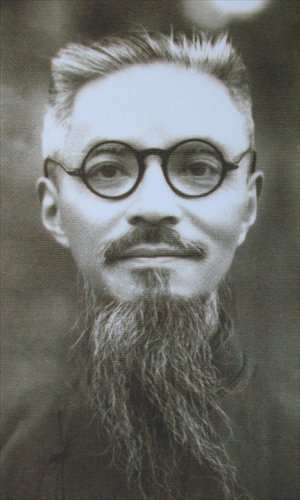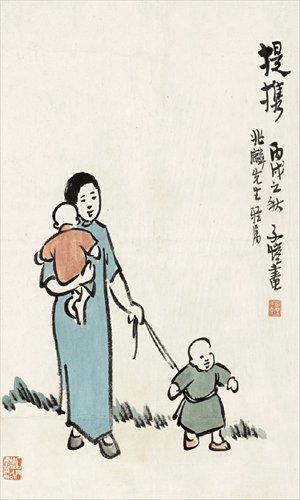Feng Zikai draws a crowd
Feng Zikai's former home, a Spanishstyle house in Shanghai. The building has recently been converted into a museum dedicated to the famous artist. Photos: IC
Near the busy intersection of Mid Huaihai Road and South Shaanxi Road in Shanghai stands a cluster of Spanish-style houses. Constructed at the beginning of the last century, and collectively known as Changlecun to the locals, the seven structures house 129 two-to-three-story units.
Feng Zikai, a renowned Chinese cartoonist, essayist and educator, lived in one of those houses with his family from the year 1954 until he passed away in 1975. He named his house "Ri Yue Lou" (the building of the sun and the moon).
A year ago, Feng's offspring bought back the second and third stories of "Ri Yue Lou" (they could not successfully reach an agreement with the current first-story residents), and have since rebuilt them into a museum, known as the "Former Residence of Feng Zikai", now open to the public.
Eighty-two year old Feng Yiyin, the only living daughter of Feng Zikai's seven children, often visits the house-turned-museum and enjoys sharing her father's life with visitors. Today's "Ri Yue Lou" truly reflects its original appearance in Feng Yiyin's memory - the artist's original desk is on display, complete with writing brushes, ink sticks, paper and inkstones. In front of the desk is an old cane chair, and against the wall there is a narrow twin bed, where Feng Zikai slept in his later years.
Feng Yiyin spent 21 years living in "Ri Yue Lou" with her father. They worked together to co-translate many foreign classics like A Hunter's Sketches and The Tale of Genji, and the artist left a deep impression on his daughter, who still carries his influence within her today.
Now, Feng Yiyin takes charge of all issues relating to her father, such as various workshops and commemorations, editing her father's works, writing his memoirs, and authorizing reproductions of his scripts and paintings.
A family that fled and found happiness
When the Sino-Japanese War (1937-1945) broke out, Feng Zikai took his whole family from their hometown in Shimen, Zhejiang Province. "We took boats, long-distance buses, and trains. That was very difficult time," said Feng Yiyin. "But as a child, I did not fear the hardships. On the contrary, I actually enjoyed all that traveling through hills and rivers." The family finally settled down in Zunyi in Guizhou province, where they were safe from the Japanese army.
Later, at the end of 1942, Feng Zikai and his family moved to Chongqing, and Feng Yiyin clearly remembers delighting in their occasional outings for dandan mian (Sichuan noodles with peppery sauce) and hongyou shuijiao (dumplings with chili oil), appreciating the simple day-to-day life there.

The life of the artist
After the war, Feng Zikai moved to Shanghai with his family, and Feng Yiyin clearly remembers the day they moved into "Ri Yue Lou", on September 1, 1954. "My father's room had a big balcony," said Feng. "He could see the moon and the sun from his new room, and so he named the house 'Ri Yue Lou'."
From then on, Feng Zikai worked at home almost every day - he translated or wrote in the mornings, and painted in the afternoons. During that time, Feng Zikai and Feng Yiyin co-translated many books, including Russian writer Vladimir Galaktionovich Korolenko's novel My Contemporaries' Stories.
But like many writers and artists in that time period, Feng Zikai experienced a lot of suffering in his later life. Feng Yiyin said during the Cultural Revolution (1966-1976), her father could only paint in secret. "He got up at 4:00 very morning and painted until we woke up," said Feng Yiyin.
The painting materials were also simple and crude. "He cared little about the ink and inkstone," recalled Feng Yiyin. "All his writing brushes were made of weasel's hair. None were made of goat's hair, which is preferred. And he only went to buy a new brush when the previous one was badly damaged."
Themes of childhood innocence

The deepest impression Feng Zikai left on his daughter was how he cherished the innocence of children. Feng Yiyin said her father adored his children and thought childhood was the best time of life. "He never demanded that we followed in his footsteps, allowing us find our own paths and interests. His biggest hope was for all his children to be happy," she said. "As a result, none of our seven brothers and sisters continued his painting career."
One of the themes of Feng Zikai's work was the world of children, and he drew inspiration from watching his own children play. "Whenever he saw a child playing imaginatively, he would begin drawing immediately," said Feng. "And the children he drew most were my oldest sister, Abao, and my oldest brother, Zhanzhan."